In 1874, Abner Sprague and his parents homesteaded along Big Thompson Creek in Moraine Park, originally called Willow Park. They constructed a cabin the following year and started ranching. Here they harvested the abundant native hay and planted oats to feed their cattle. Abner Sprague cut the timber that surrounded Willow Park and milled it into lumber. In 1888, Abner Sprague married Alberta Morrison, eighteen years his junior. She quickly adjusted to ranch life.
This is the site of Sprague homestead which later became Steads Ranch and Hotel. The two-story hotel once sat to the immediate right of the tall tree in the center of the photograph with other buildings to either side. The road to Steads Ranch ran through the foreground.
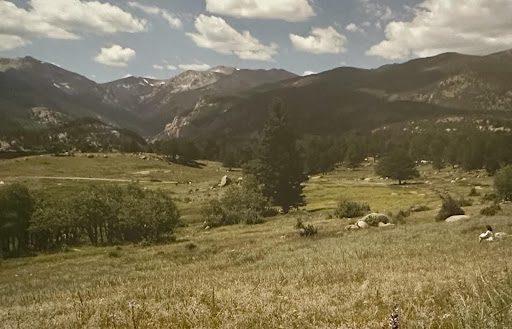
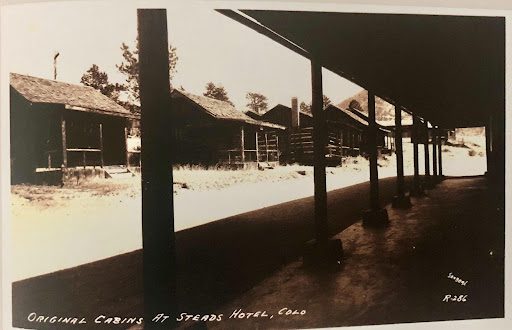
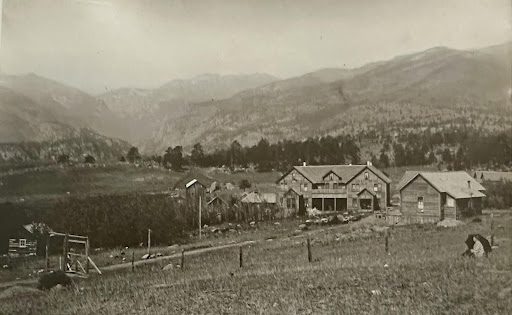
As visitation to the area increased, tourists began to stop at the ranch, asking to purchase a meal or pitch a tent in the meadow. The Sprague’s elected to ease into the tourist business with a modest investment in a few cabins. Soon the cabins were fully booked during the summer.
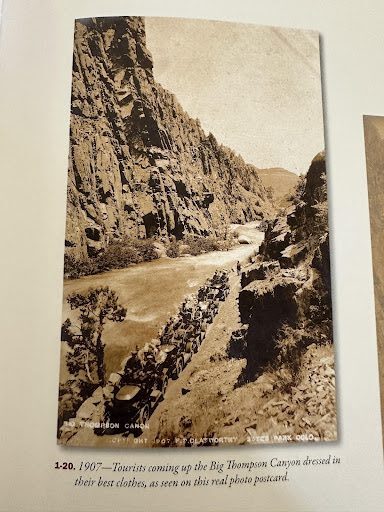
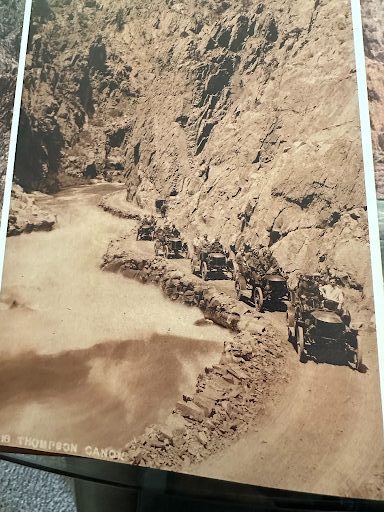
As visitation to the area increased, tourists began to stop at the ranch, asking to purchase a meal or pitch a tent in the meadow. The Sprague’s elected to ease into the tourist business with a modest investment in a few cabins. Soon the cabins were fully booked during the summer.
Sprague's Ranch began as a row of guest cabins located in Moraine Park and grew into a complex of 40 buildings. By 1904 the resort accommodated 100 guests. The property was later incorporated into Stead’s Ranch. J.D. Stead was the husband of Abner Sprague's cousin Dora. Stead became a partner in this dude ranch business. (Courtesy of Rocky Mountain National Park) This led to the construction of a large two-story log hotel with a dining room and kitchen.
At one time, Rocky Mountain National Park included similar commercial developments, many dating back prior to 1915 when the park was established. However, not unlike other national parks, officials decided to return most of the land to its natural state through the systematic purchase and removal of the many lodges within its boundaries.
According to the authors of Stead’s Ranch and Hotel, Abner and J.D. got along quite well, but their wives quarreled constantly. This led Stead to ask Sprague how much he wanted for his ranch.
In 1904, Stead borrowed every penny he could to meet Sprague's price. After Stead assumed title, he changed the name to Stead’s Ranch, later simplified to Steads.
J.D. Stead began a series of improvements and additions to the ranch, all designed to attract more tourists.
The Pine Log Inn was constructed and acted as a store. It carried clothing, groceries and provided lunches for those going on a trail ride.
Cabins, with colorful names such as the Columbine, Bungalow and Hayden, were added. The original homestead cabin was razed and replaced by a cottage named Log Cabin.
In 1909, a large dance hall was constructed, and in 1921 an 8,000-square-foot barn was added to the property. The barn had accommodations for the wranglers on the upper floor and stalls for horses and milk cows on the lower floor.


Stead’s Hotel in a 1913 postcard
Stead constructed a residence for this family in 1917 called the Rock House named for its river rock exterior.
More construction continued over the years and, to provide a reliable water supply, two small reservoirs were added. Other cabins were built including Pine Lodge, Willow Court, Horseshoes and Stars and Stripes. For long-term guests, the Gold Coast was built, and a large "L" shaped lodge called Meadow View was constructed for families.
For over three decades, J.D. and Dora Stead ran the ranch. J.D. died of a heart attack in 1931. After his death, Dora's health began to fail. She passed away in 1936, leaving the ranch to Will and Myra Lewis.
In 1950, Steads was sold to Edgar and Dorothy Stopher. They found that a great deal of work was required to make it operational. Among the major renovations was the addition of private baths in the cottages. A tennis court and swimming pool were added as amenities necessary for a modern tourist facility.
In the meantime, park officials had started the process of purchasing of all commercial development within Rocky Mountain National Park. They leased the facilities to the owners for a specific period of time.
In the case of Steads, $750,000 was paid for the ranch which included 560 acres.
The summer after her freshman year (1909), Edith Stella Knoll worked at the Steads Ranch in Estes Park with other college girls.

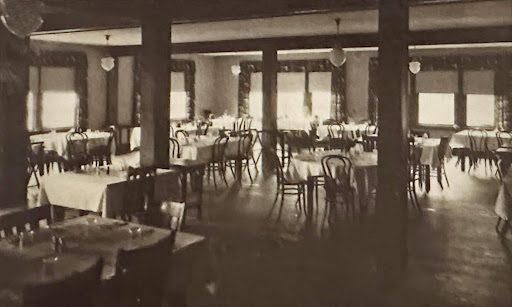
Dining Room 1909

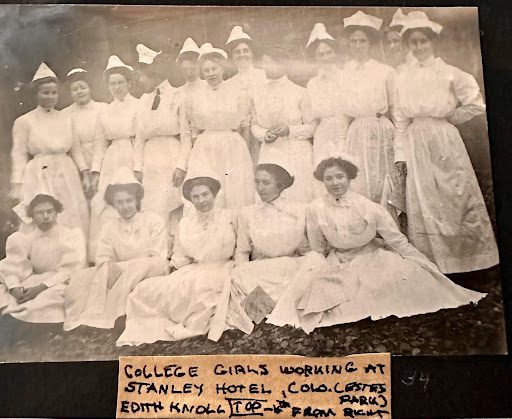
College girls working at Steads (not Stanley Hotel) 1909
Edith is standing, fifth from right
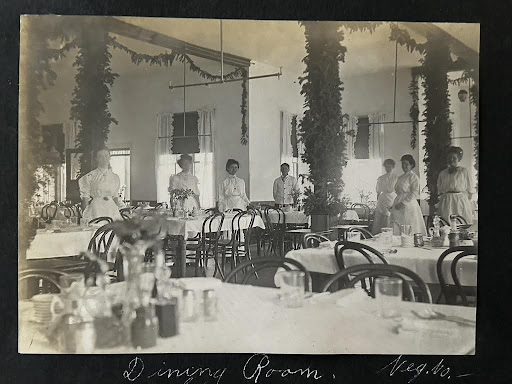
Working in the dining room, Edith is third from left - 1909



Moraine Park, Colorado July 4, 1909
Dear Orville,
This is Sunday afternoon about 2:30 have just finished the glasses and silverware. It’s raining so I can’t go out walking so I will write to you. I am sitting at the west door of the hallway up over the laundry facing the canyon where the mountains are covered with snow.
Well, I am waitress at last. I have one table of Kansas City people. One of which is a preacher (and by the way he tipped me this morning and fifty cents at that) then I have another table of people I don’t know where they are from. I like it fine. The preacher asked me this morning if I was to be their waitress all the time. Then he asked me what my name was and pretty soon he gave me the tip.
Yesterday afternoon we decorated the dining room. We covered all the pillars with red pine and hung festoons all around the walls and across the room then hung magic lanterns from them. You may be sure it is beautiful. Well, I just like it better and better all the time up here. I know I never saw anything so grand as the mountains are. I am not one bit anxious for the summer to be over with of course we have a good deal to do, and we get pretty tired too never the less, I am standing is all right. I did have the nose bleed every day for a while but have gotten over it now.
Mr. and Mrs. Stead are both very nice to me and I think they like me, too. She is going to let me make a salad someday, A kind she never heard of before. It’s a carrot salad. Probably you know what it is.
We have the best things to eat up here and I just eat all the time, it seems as if I am hungry all the time and I do believe I am getting fat. I guess it won’t hurt me for I did weigh only 110 lbs. when I came home from Collins.
We have a second cook now and if he isn’t the meanest old scamp you ever saw. He is always telling us something and it makes us mad. It’s a daily occurrence for us to scrap with him.
The very idea of you going to keep me from coming up here, why Orville you couldn’t have done it. I would have come just the same. I wouldn’t have made any such promise, and you couldn’t have made me either. But I would like to know what you’re devices were any way. You don’t know how stubborn I am when I once take a notion. I expect when you know me better you will think I am a little naughty won’t you. I suppose tho now I might give in after so much coaxing.
I received the paper and also the postcard. Was glad to get both of them. Any kind of mail seems good, especially from you. I always look forward to the time when I get your letter so you must never forget to write. I always think of you when I do go to bed and usually you are my last thought when I go to sleep, so we are even aren’t we? And I have often thought how nice it would be to take walks these beautiful summer evenings, but of course we can’t this summer. We will sometime tho.
Well, I will close now. The sun is coming out and I am going to take a walk when the grass dries up a little.
I am yours sincerely, Edith
P.S. How about my chickens. Did they hatch? Did Mr. Wilson get married? I saw in the paper that Mr. Anderson, one of Miss Byers fellows, was married not long ago. I am afraid she lost out all around. Poor thing.
Address: Moraine Park, Colorado
(Note Edith’s spelling of these words: Hall not hawl, scenery not cenery, Methodest, uncomfortable, Hawaii.)
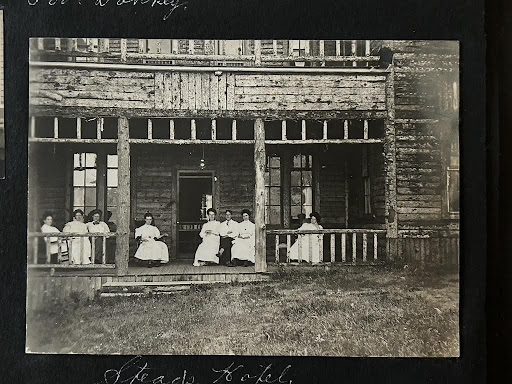

Hair washing day. Girls having fun! Edith is between her two friends.

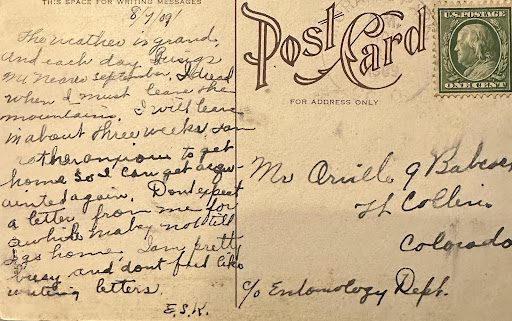
Postcard from Edith to Orville, August 9, 1909.
Edith’s postcard: “The weather is grand, and each day brings me nearer September. I dread when I must leave the mountains. I will leave in about three weeks. I am rather anxious to get home so I can get acquainted again. Don’t expect a letter from me for a while maybe not until I go home. I am pretty busy and don’t feel like writing letters.” ~ E.S.K.
When Congress passed the Rocky Mountain National Park Act in 1915, the legislators focused on Rocky's scenic and natural wonders. Still, what became the park held many cultural treasures including ancient trails, game drives, cattle ranches, and lodges. Early superintendents tried to develop roads, backcountry cabins, and trails to blend with the surroundings. Rangers manipulated the landscape to look more "natural;" they suppressed fires, planted seedlings, and controlled predators. The National Park Service purchased private lands and removed buildings, roads, post offices, driveways, irrigation ditches, and fences.
After World War II, with park visitation increasing across the country, the National Park Service implemented Mission 66, a nationwide development and improvement program. Rocky Mountain, like many parks, suffered from outdated facilities. Mission 66 brought new comfort stations, overlooks, employee housing, campgrounds, and visitor centers to Rocky Mountain National Park.
During the 1960's, as cultural revolutions swept the nation, Congress passed significant environmental laws to protect the American landscape. Many of these affected the management of both natural and cultural resources in the National Parks. Every year, more cultural resources are identified and protected in Rocky Mountain National Park.
Steads Ranch continued to operate until 1962 when the lease expired, and the National Park Service took over the property. Razed in 1963, Steads Ranch, located in Moraine Park, included a swimming pool, golf course, rodeo grounds, stables, guest houses and a hotel. In addition to the removal of buildings, the swimming pool was filled, and the golf course reseeded with native grasses. The Park Service was so thorough that only bits of pavement and an occasional posthole can be found today. Of the thousands of people that come to see the elk, few are aware this extensive commercial development was once located in the park boundaries.

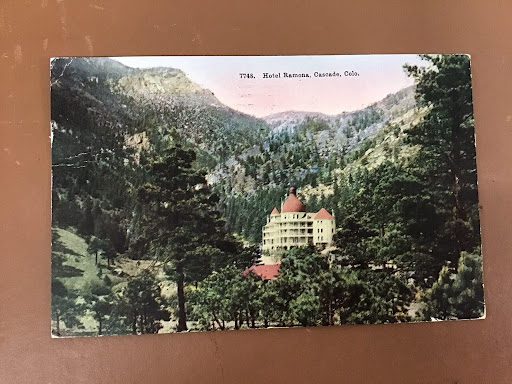
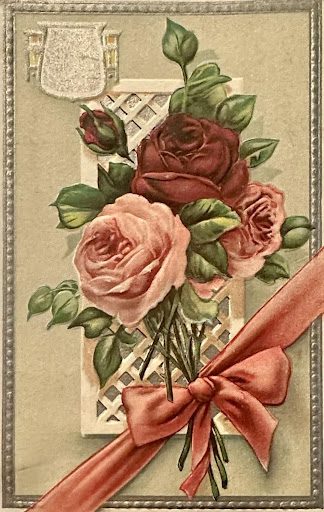
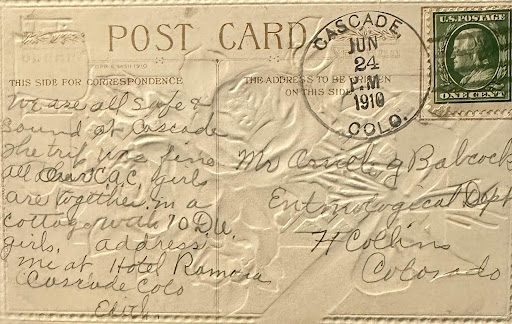
We are all safe and sound at Cascade. The trip was fine. All our CAC girls are together in a cottage with 10 DU girls. Address me at Hotel Ramona, Cascade, Colo. ~ Edith
